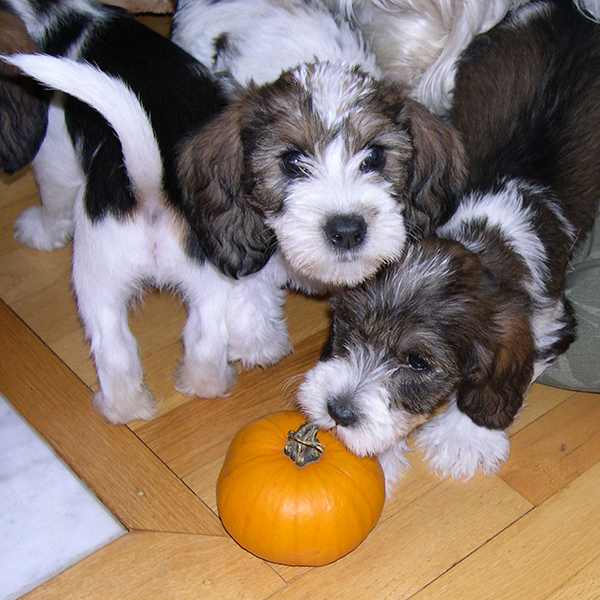Judges Education Slideshow
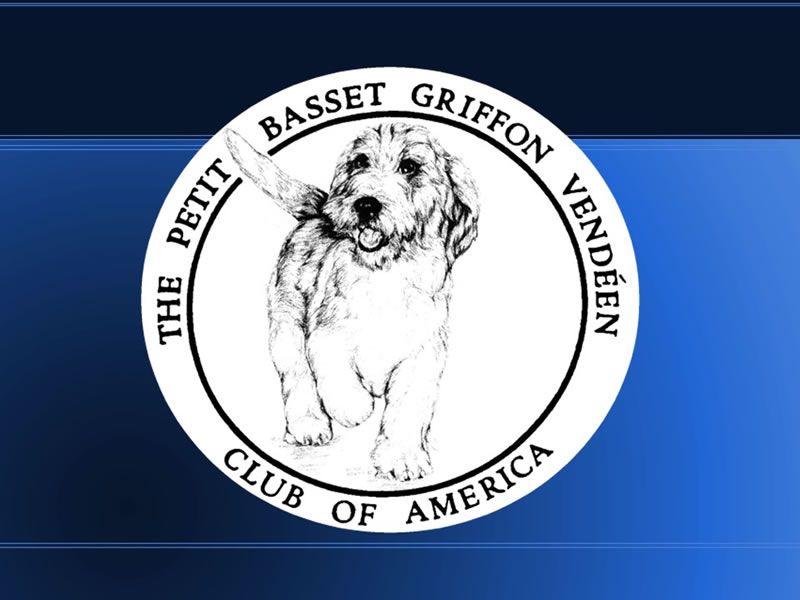

Thank you for your interest in the PBGV. We hope you find this presentation helpful to you as a breeder and as a judge of the breed.

Welcome to the PBGV Club of America Education Program! The program is designed to give you insight to the PBGV's history, necessary structure for his original purpose and his unique character.

The PBGV is compact and casual. Note the overall appearance.

History: The Vendee area, Western coast of France, is rough, replete with rock, thorn and thicket. The breed developed to be followed by man on foot to hunt in this difficult terrain.

His name tells us much about him!

The PBGV is far lighter in construction, shorter in body length, and generally far more active than our Basset Hound. Note the long ears of the Basset, his length of body. One can also see the more moderate angles here on the PBGV.

To suit the size prey and terrain, most French hounds were developed in three sizes. The hound of the Vendee, however, developed in four.

Normally the French developed their hounds in 3 sizes. The Vendeen hound, developed in 4. Griffon Vendéen breeds at the French Club Show : the PBGV, the GBGV, the BRIQUET and the GRAND GRIFFON. You might wonder do grand and basset oppose each other; no, large and small refer to the size of game pursued. Basset means “low”. Thus we have Grand basset and Petit basset.

Until about 1975 in France the GBGV and the PBGV were whelped in the very same litters. In 1976 the two breeds became separate. In many ways the Briquet, the medium sized Vendeen Hound pictured here (above) resembles the PBGV. Note the shorter body length and his foreface and ear yet the decidedly long legs. All 4 have rough coats.

Today the Grand lower limit in U. S. is 15 1/2” and upper limit nearly 18” while the Petit is 13”to 15”. Very early on the French considered any dog under approximately 17-18 inches “basset”.

It was approximately 1975 when it was declared that the two breeds, PBGV and GBGV, were separate and could no longer be interbred. On left we have a PBGV; on right the GBGV. Notice the heads, lengths of leg, backline, and tails.

PBGV has been reduced in all its proportions, not merely the long bones as in the Basset Hound, therefore PBGV is generally not considered dwarfed.
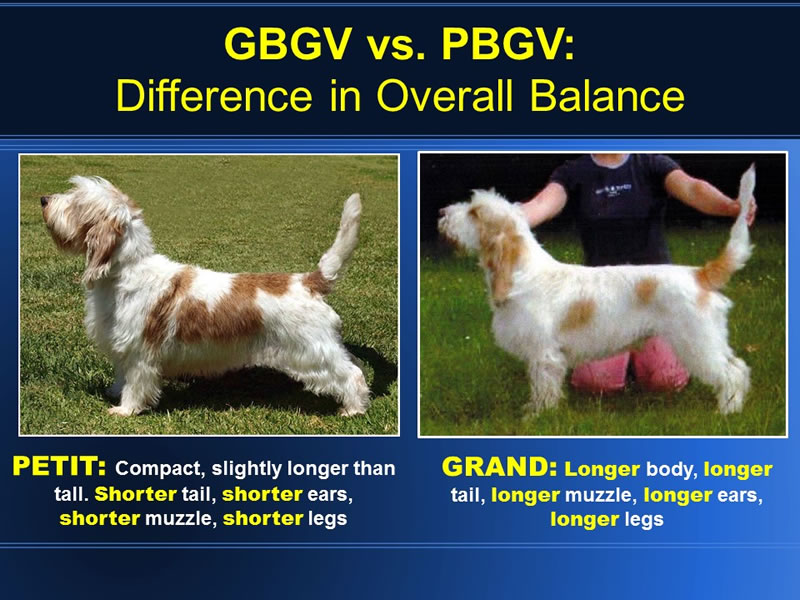
Note the Petit on left is more compact from withers to rump, and the Grand on right is longer in body, tail length, ear and muzzle.
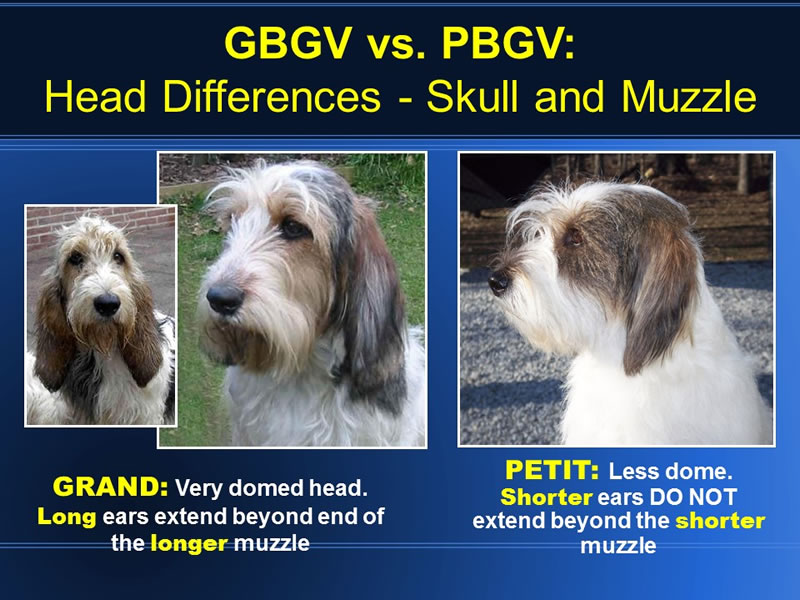
Note the very domed head of Grand on left and more oval less domed skull of Petit on right.

A brace of PBGVs and GBGVs, Club Show . Notice which two are ‘ever busy’? and which are more laid back?

Head on view of the two. Note the straighter leg of grand and the slight crook in Petit leg. Of course height is different as well.

Now, though similar in height, put your thinking caps on… which is Grand and which is the Petit and why? We will not see many so similar in size today as the PBGV is 13 -15” and the GBGV is 15 ½ - 18”.
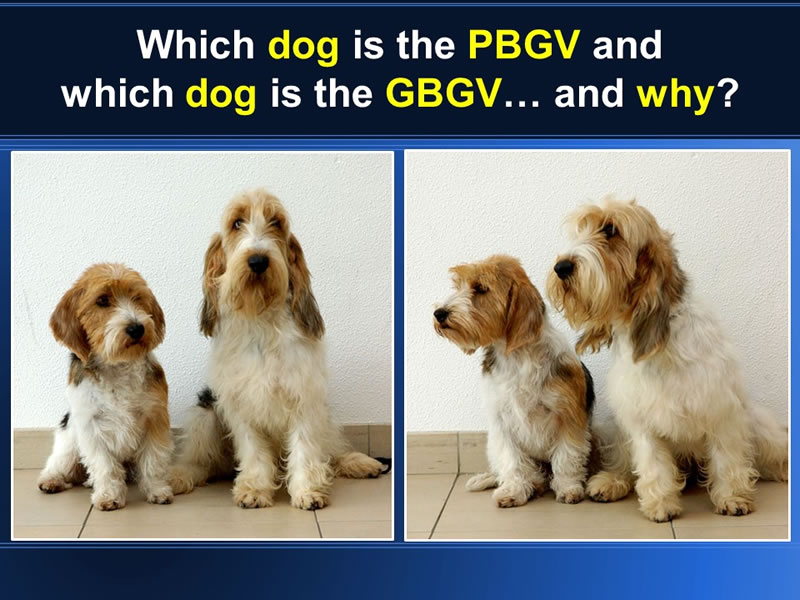
Petit and Grand side by side. Which clearly is the PBGV? These photos show those head differences.

Petit & Grand side view. What do you notice here? Take note of the beautifully casual coats on both PBGV and GBGV Standard: long without exaggeration.

Early US Development: Elizabeth Streeter with her Skycastle pack. These dogs were about 15/16ths pure-bred. Mrs Streeter kept very detailed records on pedigrees. She did an outcross to a Basset Hound in an attempt to make the PBGVs a bit more tractable. The current Skycastle Pack is pure-bred and includes several French imports. Elizabeth Streeter had hoped to spare the PBGV the show and pet scenario. Hers was always the pack to beat at the Aldee, VA Pack Meets.

The Skycastle Pack today. Several dogs of Skycastle breeding are AKC Champions of record. Bred to be followed on foot locating hare. Inset shows one of the Skycastle PBGVs. Several of the pack are bench champions. Note the head, ear and muzzle, the tail and body.

A bold hunter-vivacious, whose furnishings, long without exaggeration, protect him in the thicket.

They’ll even swim when necessary.
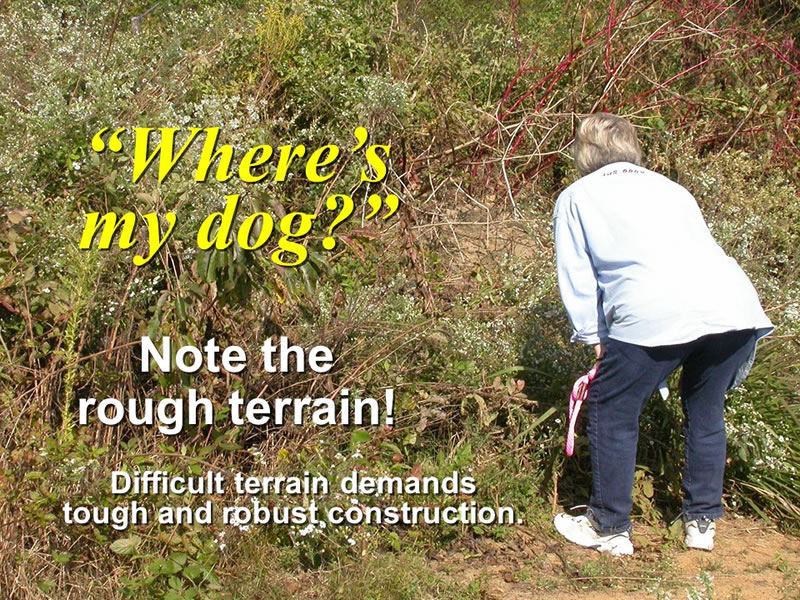
Where’s my dog?

PBGV’s work in rough cover, requiring a harsh protective outer coat (long w/o exaggeration), and a shorter, denser undercoat to minimize injury.

It is said that PBGV’s have just two speeds – “GO” and “SLEEP”!

Versatility: A PBGV can do Obedience well.

He is agile!

Agility ….he enjoys. Note the casual disarray of coat. Such enthusiasm!

Versatility: They do Tracking as well.
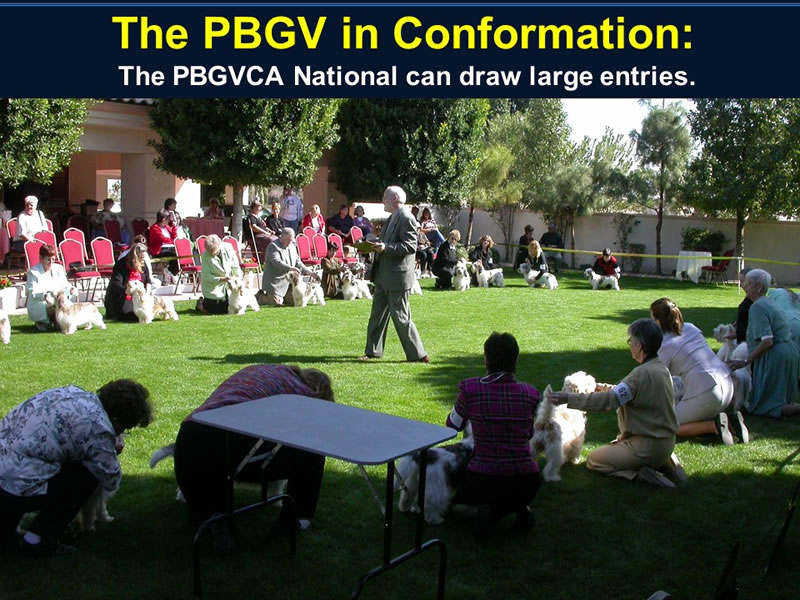
National Specialties can draw a significant entry. Our National in Nashville, drew some 180 entries. That was in ‘07. Today with the economy the shows are smaller, often fewer than 100.

Note good toplines, casual coats.

IF you remember nothing else remember this paragraph on general appearance from our standard: compact, tough, bold, vivacious in character.

IF you remember nothing else remember this paragraph on general appearance from our standard and the description of coat in coat section. One will see all varieties of coats.

Is this dog short on leg or are there just too much furnishings on the bottom line? Or is it very acceptable in your opinion? FEEL! Opinions will vary!! Standard says “long without exaggeration” and harsh to the touch.

You can see the coats are of different qualities and quantities. Casual and tousled is key. Standard says coat long without exaggeration and harsh to the touch. The coat quality will vary, but all should appear tousled, which means a bit disheveled and in disarray. Compare this coat to the coat in the last slide. Both are acceptable.

You can see the coats are of different qualities and quantities. Casual and tousled is key. Standard says coat long without exaggeration and harsh to the touch. The coat quality will vary, but all should appear tousled, which means a bit disheveled and in disarray. Compare this coat to the coat in the last slide. Both may be acceptable depending on your background and experience.
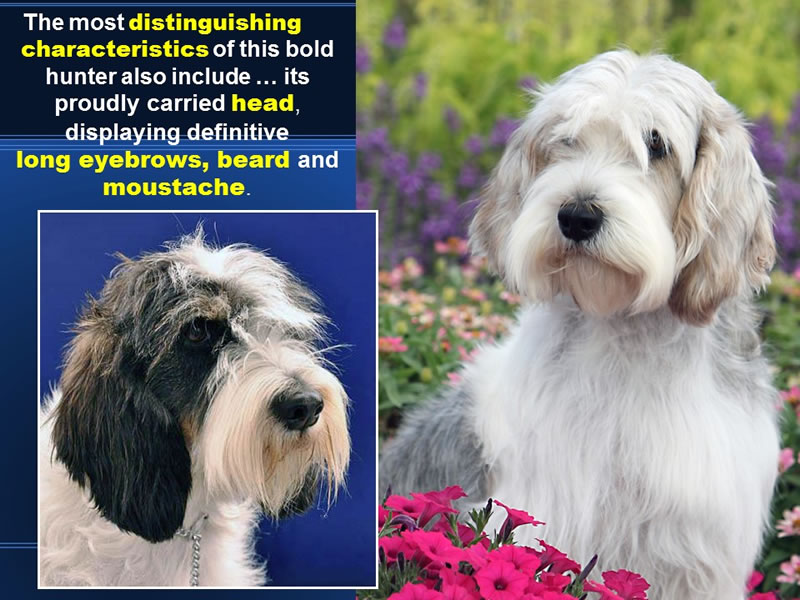
Note the little fan from muzzle up the nose settling into eyebrows; this is necessary as it is protective. It is also one of the minutia of breed type.

Generally carried at about 2 o’clock but has various carriages depending on mood. It should not be carried over the backline.

If you remember nothing else remember this statement from general appearance. You will see and hear this several times during this presentation. Please remember it. We have, of course, differing interpretations both by judges and breeders of exactly what casual and tousled means! We want that look created by the natural trimming of coat by brush and bramble as if the dog has hunted.

Tousled does not mean tossed. Tousled means in disarray.

Maintaining the casual appearance. Note the lovely head, topline and proportion. This dog is likely at the top of the standard.

Adjectives to remember directly from our standard.

When examining and evaluating a PBGV keep in mind the above quotation from the Breed Standard. Look for virtue first and assess fault according to extent of the deviation from the ideal. Note a lovely expression here, created by the dark eye, the darkly pigmented nose, the little fan to eyebrow, the supple, narrow and fine ear. Note the hair on the ends of the ears also required by the standard.
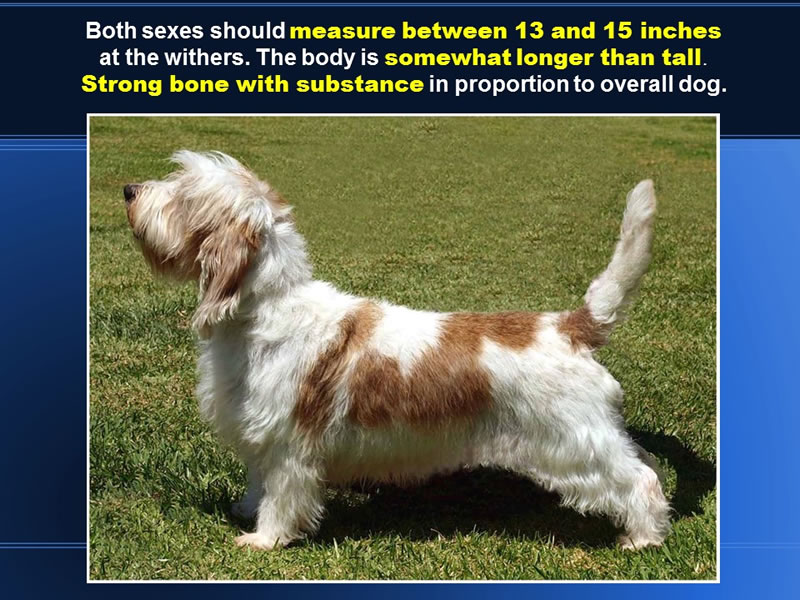
An example of correct breed type and proportion in a PBGV: compact, casual and tousled. Rear is set a bit too far back, making topline slope a little.

These photo- shopped PBGV’s get the point across: PBGV is compact, not long and low.

Wind is blowing eyebrows back on both dogs but you can see they are there. Note correct fan of hair between eyes of both dogs. This fan is protective and necessary. It is a very important element of breed type and should not be removed.

Some handlers will groom hair off of ends of ears to make them appear shorter. But the standard says “covered with long hair” Measure the ear leathers, not the hair on the ears. Ears (leathers) should not extend past the nose when they are pulled forward. Beautiful dark eye here as well. The ear set, the dark eye, fan up the muzzle and between the eyes makes for the alert and intelligent expression.
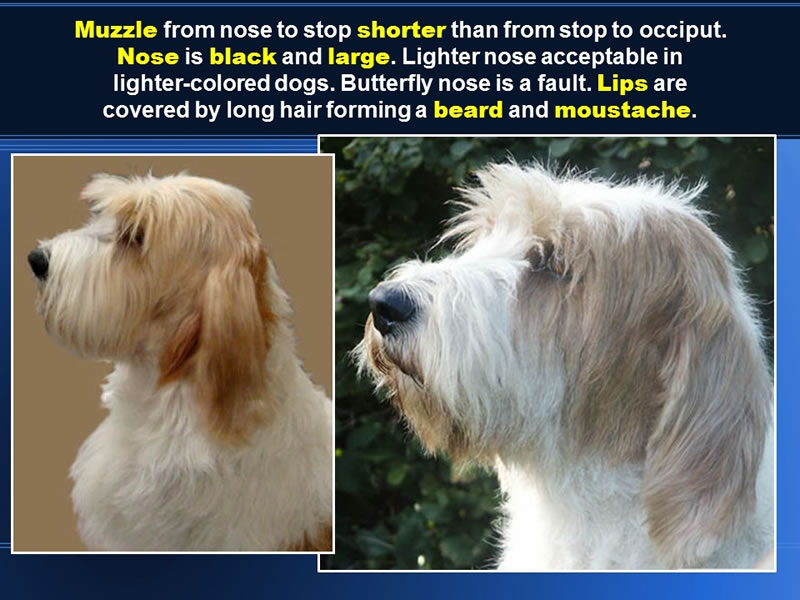
Note that a light nose is NOT a butterfly nose. Butterfly nose is a fault, not a DQ. Consider the whole dog when judging; do not focus on one item unless that item is an extreme departure from the ideal.

Thoughts on rear; handler fault? Pulled so far back to level out topline? Is thigh too long? Tail appears low set but note the color just above the set on. Ear looks too long?, feel! Too much tuck up. feel? Stretched too much to determine angles? Feel!

This dog is in a more balanced stack; he looks comfortable. He is a good example of breed type yet different from the dog in the previous slide. From this photo, it could use a touch more rear angle. We expect this dog to be a sound mover. Without as much coat one can see the body proportion here. Note casual!!

Height at the elbow should be slightly more than ½ the distance from withers to ground; note the more casual coat and the more correct stacked profile w/o handler over stretching the rear. Length of leg is very important. We do not want short legged PBGVs nor do we want long legged PBGVs

There can be a difference in how a dog is set up for exam vs. how he stands naturally. Feel the front for its correctness, then move the dog to determine the usefulness of his front structure.

Pick the feet up, feel them and look at the pads if you have any doubts.

The standard does not mention shoulder or rear angle measurements. The above is a 90 degree sketch. The PBGV ‘s angles are a little more moderate, possibly 100 degrees.

This dog is a lovely example of compactness, in balance, nice angles front and rear, rough overall appearance. A dog that fits the standard.

Condition is very important in this hunting hound. Feel for muscling.
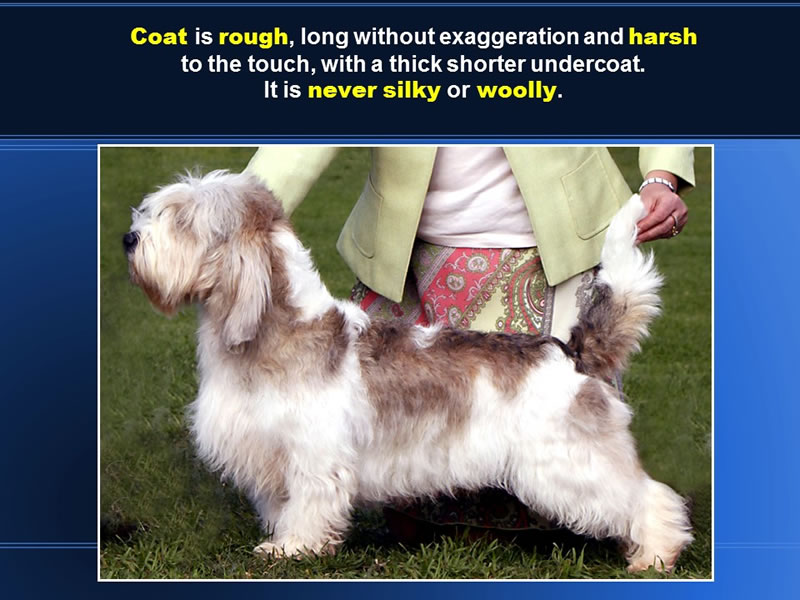
Long without exaggeration, harsh to the touch, with thick, shorter undercoat. Never silky or wooly. The look should be as if torn by rough terrain, not just combed for a photo. Dog here is a bit overstretched.
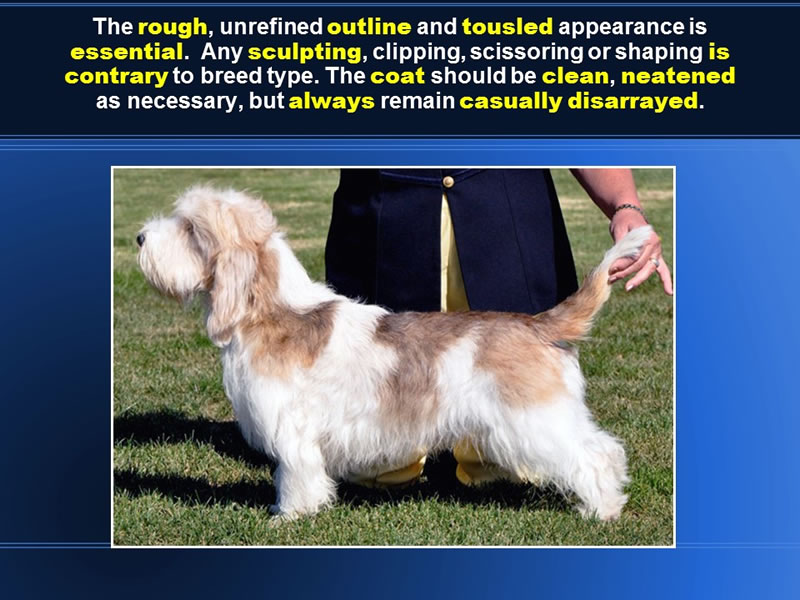
A bitch hound of good proportion and casual.

Casual in overall appearance. Body balanced, good head, tail ,topline, length of leg.

Coat in casual disarray. Topline gives the appearance of level but the dog should possess a muscular loin; this may or may not be seen but will be felt in the examination.

Compact, casual. Note the differences in the coats we have seen. Look for the overall package; slightly longer than tall 13 to 15 inch dog strong and sound with a coarse coat.

Comments or questions?

Free and Easy at all speeds.
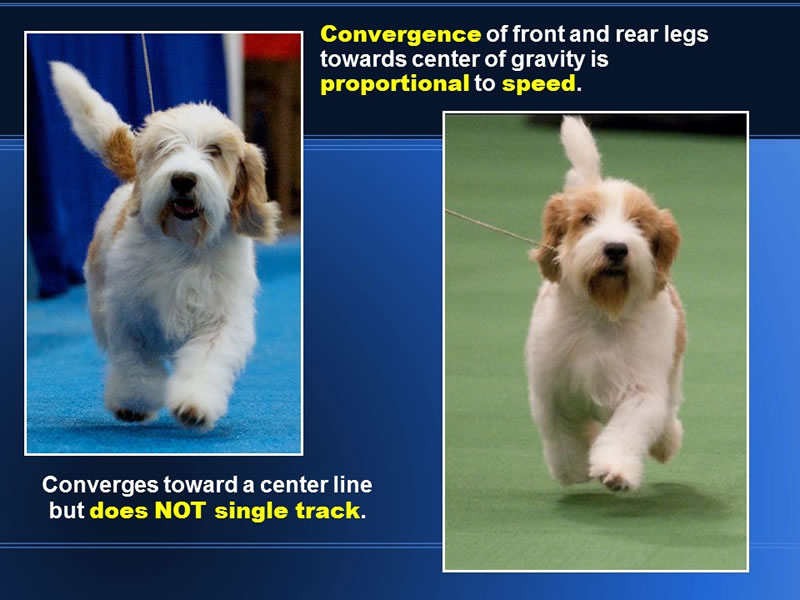
Convergence is for body support.


Easy and free preserves energy.

Ease of motion is energy saving.

Note the convergence in front leg and footfall. Support of body is what it is all about.

This dog is moving nicely: body will follow head.

Pack hound: He must get along well with other dogs and with his humans. Photo from French National.

The word “cute” …. They are cute but they are also tough little hunters. Remember that. Standard does not mention cute.
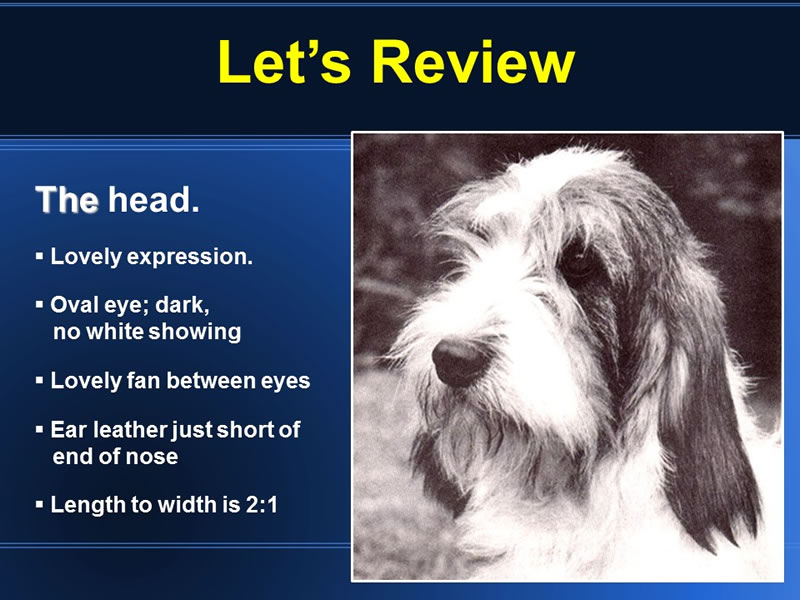
The Petit head has a ratio of 2:1 length to width, a somewhat oval eye, ear leathers just short of the end of the nose. Expression is alert and intelligent. Note the lovely fan between the eyes, up from muzzle. This should not be removed but is a detail of type.
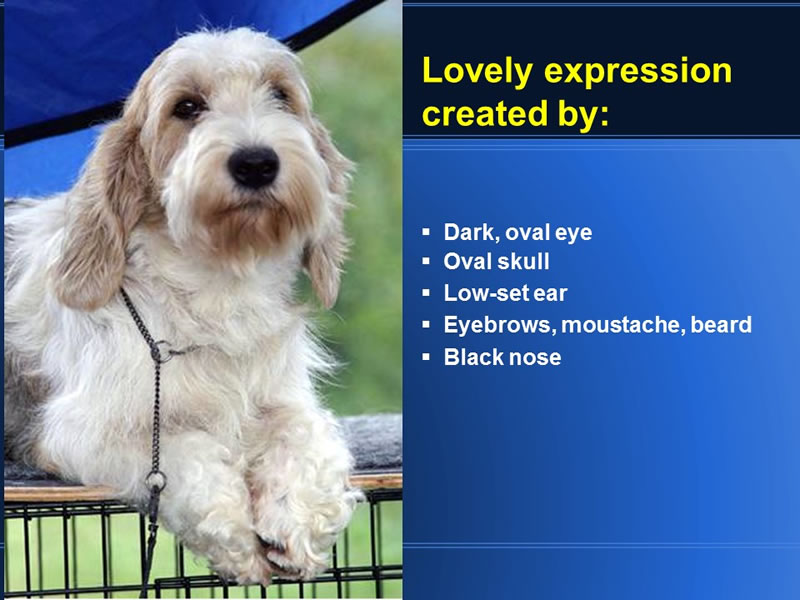
Note the little fan, protective again. Intelligent expression. Eyebrows stand forward but do not obscure the eyes. Offensive is the blunt scissoring of eye brows visor like.

We do not want any blunt scissor marks. Blunt scissor marks destroy overall casual

Note the head when moving: carried up and forward. Tail at about two o’clock. Note how easy this dogs moves.
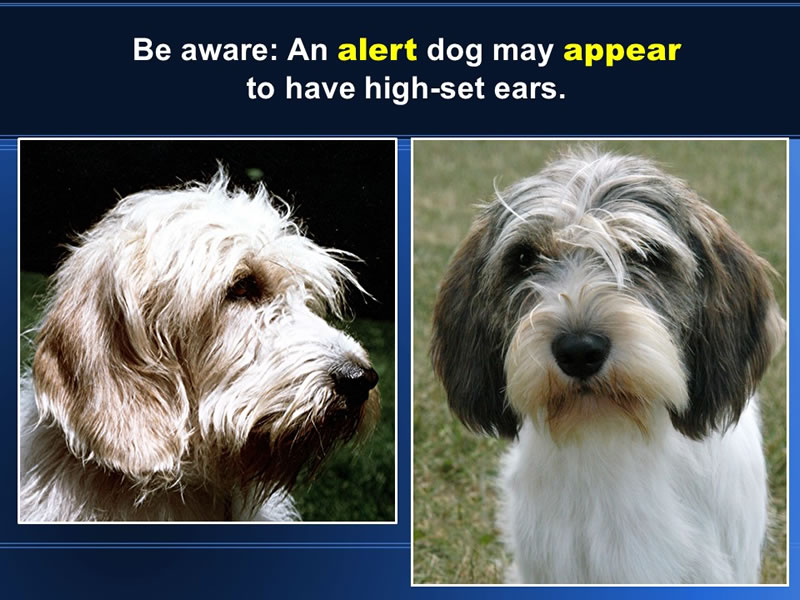
Do not assume earset is high because dog is alert. This breed is ALERT much of his waking hours!
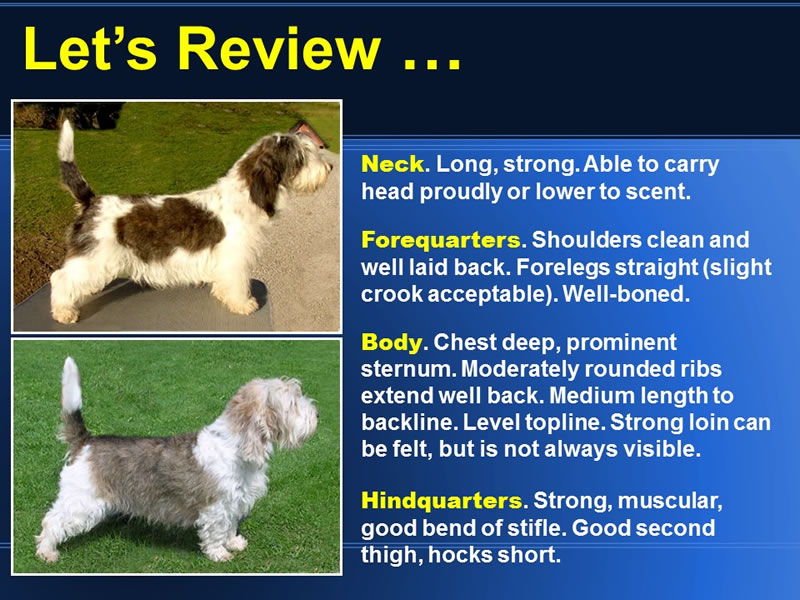
These dogs show body proportion, level topline and neck. Their hind legs stretched behind them a little too much. PBGVs angulation because of his height and length, is moderate and not 90 degrees as required in the ideal Basset of Dachshund.

Breeders tend to talk about nice short tails because one of the early problems was tails overly long. Standard calls for medium tail length.


This is the very same dog from 8 weeks to 2 years old. Note the leg length at 8 weeks. Note how color can change as well.

This is the very same dog from 8 weeks to 2 years old. Note the leg length at 8 weeks. Note how color can change as well.

Age does not generally change proportion. This dog will likely be long and low as an adult too--not appropriate for PBGV.

Balance stacked. Note compact body, length of leg, neck, level topline, medium length to tail and its rather high set generally carried at 2 o’clock, but carriage will vary according to mood. Casually disarrayed.

Good dogs have faults and virtues. Minor faults are dwarfed by virtue in good dogs. Grooming and stacking can create illusions. Judge the whole dog. How he uses himself and moves will determine too much or too little of some trait. This dog appears on the lower side of the standard for size; remember 13-15”. Note the general appearance: casual.

Correct front, visually straight. A slight crook is acceptable. Ears could be more supple and fold and the hair should have been left on.

Chest and sternum. Feel for the presence of sternum. Not nearly so much as Dachshund or Basset but more than a 15” Beagle.

Correct tail on an excellent PBGV type. Tail medium but with slight curve; never over the back or curled. Notice the lovely head and front straight on.

Presentation-The breed is meant to be natural and casual. Excessive is easier said than defined precisely. Educated opinion will vary depending on one’s background and experience. Some of the practices not casual are: trimming all hair off the ears when standard says they are covered with long hair; cutting eyebrows off; trimming around each toe, scissoring bluntly any part of the body hair, smoothing out every wisp. Casual is appearing as if randomly shortened by brush and thicket of the rough terrain.

Incorrect coat outlines. Above: too much coat is a hindrance in the field and hides conformation in the show ring; too little is not protective. Be aware that colored patches do not grow hair as profusely as white areas. And young dogs with very good strong coats will have sparse furnishings.

Again, the correct outline and typical useful coat, long without exaggeration, harsh to the touch. Thick shorter undercoat.

Is this dog short on leg or are there just too much furnishings on the bottom line? Or is it very acceptable in your opinion? FEEL!

And young dogs with very good strong coats will have sparse furnishings. Patches of color will not grow as thick or lengthy.

A short coat on a puppy (top photo) may well be an indication of correct, wirey coat just growing. Acceptable coat (bottom photo).


Salto – proponent stud dog who helped to set correct type for the modern PBGV in the US. England and Denmark. He was WHELPED in France.

Compact, casual.

Young dogs with great coat texture may have sparse furnishings. He is over stretched in rear, you can see the correct forequarters and hindquarters on this dog. Moderate angles, lovely head with eyebrows prominent, mustache and beard with beautiful ear, moderate neck, level topline; high tail set, medium tail length, compact body.

Temperament.

PBGV’s have attitude.

Called the happy breed in England!

Extroverted!

Independent (note the people in the background going in the opposite direction!)
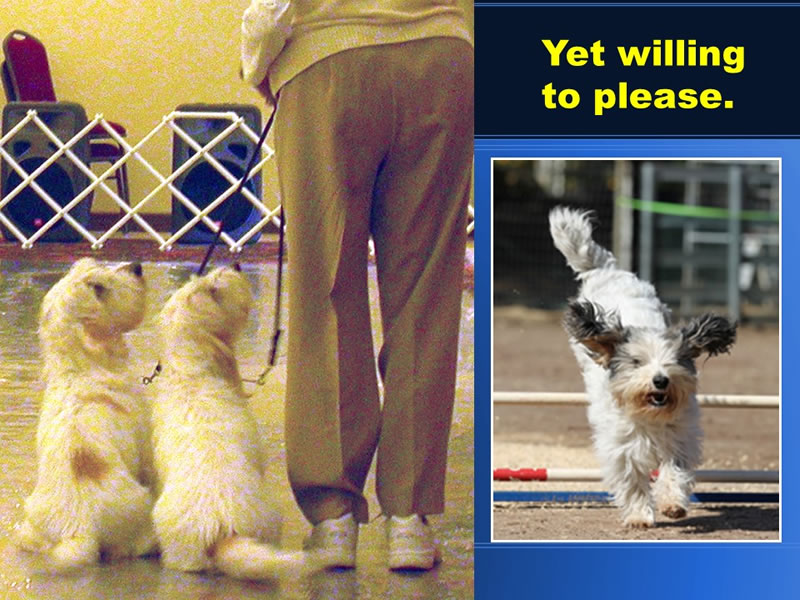
Yet willing to please.

Need a rest, not yet.

Start of grading of dogs and classes by audience. Body balanced, good head, tail ,topline, length of leg. Coat soft? Again: Feel.

In this photo there are many issues. A little high in rear. Move him again and see what he does with the topline moving. Appears a little straight in shoulder and short in upper arm. Slight dip in topline, however, move him to see what he does moving and how he handles himself. Not as well-angled behind and a bit short on leg.

Coat is long and too straight, it hangs like a Beardie. Ears look long and thick. Again, feel them. Hair taken off rump below tail does not fit with the rest of the grooming, making the dog look heavy in front-- IN this photo and photos can lie. Skull appears flat and twice as long as muzzle, not “slightly” longer.

High in rear and short in neck in photo. May be handler error-move dog again to see if he levels out naturally.

Place this class. All decent representations of the breed. Any choices with reason justified by reference to standard are acceptable. One would be lucky to have all these dogs in same class. Move them again to make your final placement.


Do you agree with this judge’s class placements? Which would you place first? C first! but all are typey.

So much depends on how the dogs use what they have. You have checked a profile, gone over all and know what you felt; couple that with their ease around and their proper support of body down and back. Know your reason.

Notice these faults all are structural and might impede movement.

Where is the hair? Overly trimmed?! Adequate topline and acceptable enough proportion. Could use more rear angulation. Dog is a little straight at both ends.. Does that front assembly support his weight?

What breed is this? When it looks like another breed, it is not typey!


PBGV, GBGV, Briquet and Grand Griffon Vendeen.














